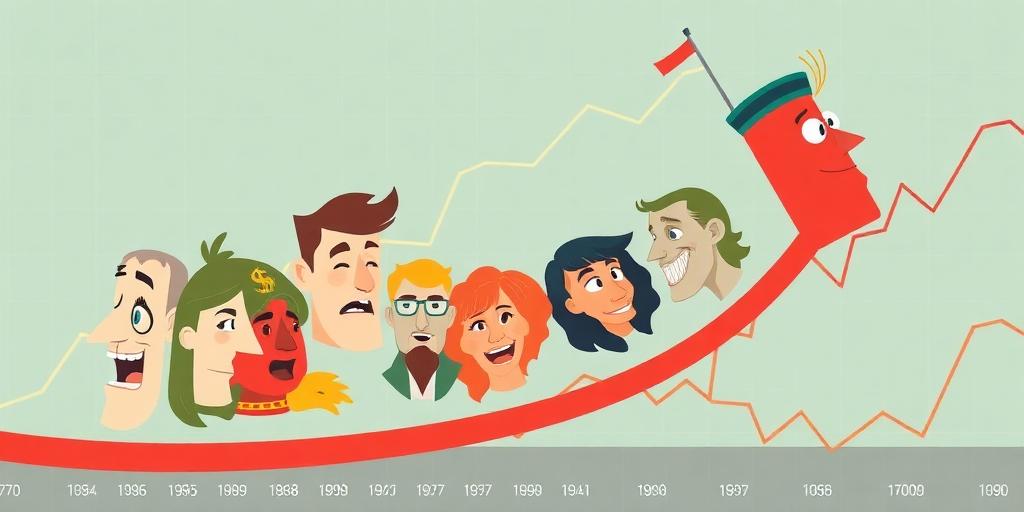The Cycle of Market Emotions: Identifying Where We Are Now and What's Next
Understanding market emotions is crucial for making informed investment decisions. The market is not solely driven by rational analysis; it's heavily influenced by the collective emotions of investors. These emotions tend to follow a predictable cycle, and identifying where we are in this cycle can provide valuable insights into potential future market movements.
The Emotional Cycle of Investing
The emotional cycle of investing typically includes the following stages:
- Optimism: This phase begins after a market correction or bear market. As prices start to rise, investors become cautiously optimistic. Positive news and economic data fuel this sentiment, drawing more participants into the market.
- Excitement: As the market continues its upward trajectory, optimism turns into excitement. Investors become more confident, and the fear of missing out (FOMO) starts to kick in. Media coverage becomes increasingly positive, and stories of quick riches abound.
- Euphoria: This is the peak of the market cycle, characterized by irrational exuberance. Valuations become stretched, and caution is thrown to the wind. Everyone is talking about the market, and even novice investors feel like experts. This phase is often marked by unsustainable growth and speculative bubbles.
- Anxiety: The first crack in the market's foundation appears. Negative news or events trigger a sell-off, shaking investor confidence. Optimism begins to wane as investors start to question the sustainability of the market's gains.
- Denial: As the market declines further, investors enter a state of denial. They believe the downturn is temporary and that prices will soon rebound. They hold onto their losing positions, hoping for a quick recovery.
- Fear: The denial phase eventually gives way to fear as the market continues to fall. Investors panic and start selling their holdings to cut their losses. Media coverage turns negative, further exacerbating the fear.
- Desperation: This is the bottom of the market cycle, characterized by extreme pessimism. Investors are completely demoralized and believe the market will never recover. Selling reaches its peak, often leading to a capitulation phase where prices plummet sharply.
- Hope: After the market bottoms out, a sense of hope begins to emerge. Investors start to see glimmers of positive news and believe that the worst is over. This phase marks the beginning of the next cycle, as the market starts its slow climb back to recovery.
Identifying Where We Are Now
Determining the current stage of the market cycle requires careful analysis of various factors, including market sentiment, economic data, and technical indicators. Here are some key indicators to watch:
- Market Sentiment: Gauge investor sentiment through surveys, polls, and social media analysis. High levels of optimism or fear can be contrarian indicators.
- Economic Data: Monitor key economic indicators such as GDP growth, inflation, employment, and interest rates. These data points can provide insights into the overall health of the economy and the potential direction of the market.
- Technical Indicators: Use technical analysis tools such as moving averages, trend lines, and oscillators to identify patterns and potential turning points in the market.
What's Next?
Predicting the future with certainty is impossible, but understanding the emotional cycle of investing can help you anticipate potential market movements and make more informed decisions. Here are some possible scenarios based on different stages of the cycle:
- If we are in the optimism phase: Consider gradually increasing your exposure to the market, but remain cautious and diversify your portfolio.
- If we are in the excitement phase: Be wary of excessive hype and speculative investments. Take some profits and rebalance your portfolio to reduce risk.
- If we are in the euphoria phase: This is a time to be extremely cautious. Consider selling a significant portion of your holdings and waiting for a market correction.
- If we are in the anxiety or denial phase: Avoid panic selling and focus on the long-term fundamentals of your investments. Consider using this opportunity to buy quality assets at discounted prices.
- If we are in the fear or desperation phase: This is often the best time to buy, as prices are deeply undervalued. However, be prepared for further volatility and have a long-term investment horizon.
- If we are in the hope phase: Gradually increase your exposure to the market as confidence returns. Focus on identifying undervalued assets with strong growth potential.
Conclusion
The market is driven by emotions, and understanding the emotional cycle of investing is essential for success. By carefully analyzing market sentiment, economic data, and technical indicators, you can identify where we are in the cycle and make more informed decisions about your investments. Remember to stay disciplined, avoid emotional impulses, and focus on your long-term financial goals.









